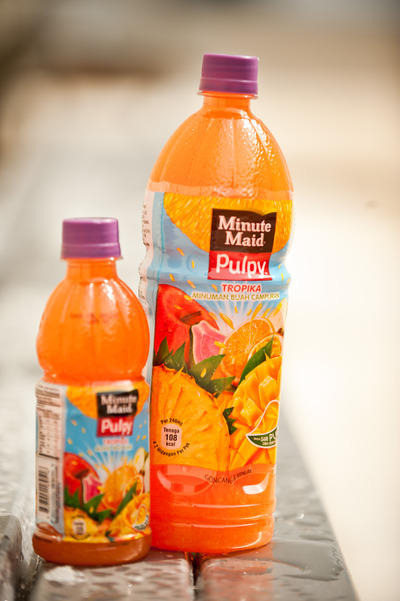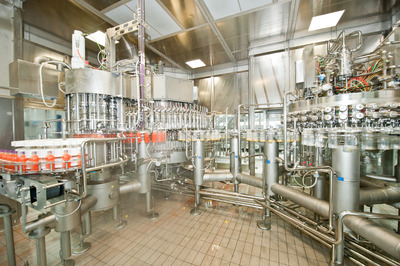Processing and filling technology for liquid-food beverages
Tuesday, 21 February, 2012
BIG (Bottling Investment Group), the production firm of The Coca-Cola Company, has gained a foothold in Malaysia with a greenfield facility serving as a showcase for bottlers in the entire region. The plant was designed to meet the needs of Coca-Cola’s move into the liquid-food beverage market. The plant has a number of sustainability features and innovations including the twin-flow filler in monobloc design from Krones, with separate pre-dosing of pulp and subsequent filling of juice on a PET hotfill line.
On a 120,000 m2 site surrounded by oil palm plantations in Enstek, Kuala Lumpur, BIG built a hall 20,000 m2 in size. Up till the start of production in 2011, the hall has seen three complete Krones lines commissioned: a PET bottling line for carbonated soft drinks (CSDs) rated at 43,200 bottles an hour, on which Coca-Cola’s entire range of carbonated products is filled, plus Schweppes and the alcohol-free root beer A&W Sarsaparilla; secondly, a canning line rated at 90,000 cans an hour; and thirdly, a PET hotfill line rated at 36,000 bottles an hour. According to Krones, this is the first line anywhere in the world to feature a Modulfill Flexifruit (Sensometic VP-GW) filler with a pulp pre-dosing starwheel.

Fruit juices with a pulp content have recently gained in popularity, particularly in Asia markets. TheMinute Maid Pulpy product has now become Coca-Cola’s 14th brand with a billion-dollar turnover. “We will be transferring the successes achieved with these liquid-food beverages to other countries as well, with the wave currently rolling west from Asia,” says the Engineering Director at BIG, John Holzemer. “So far, there hadn’t been any in-house-produced Coca-Cola fruit juices with a pulp content in Malaysia - we imported Minute Maid Pulpy from China. So Malaysia was, in fact, the perfect location for the new process and filling technology.”
At present, there are three products being handled on the hotfill PET line in Kuala Lumpur: Minute Maid Pulpy Orange, Minute Maid Pulpy Lemon and Minute Maid Pulpy Tropical in 350 mL and 1 L containers.
Pre-dosing starwheel and juice filler
Separation of pulp and fruit juice is meticulously observed throughout the whole production and filling process for the Minute Maid products: this begins in the syrup kitchen where the freeze-concentrated pulp and the fruit-juice concentrate are handled separately and is continued in the newly developed filler. Krones had been working on the technical concept for the twin-flow-filling process since 2008, in close cooperation with and following specific stipulations laid down by Coca-Cola. Among the goals involved was not only high dosing accuracy, but also very gentle product handling.
The Contiform H24 blow-moulding machine is monobloc-synchronised with the filler. The freshly blow-moulded containers are first passed to a pre-dosing starwheel with 40 filling units, each featuring five valves: one main valve with a large diameter for filling the viscous slurry (this is the part of the juice containing fruit fibres and/or fruit chunks, which is prepared and dosed separately), with fibre sizes up to 10 mm, a second valve for returning and circulating the product for heat-holding purposes, plus another two valves for setting the slurry pressure, and a fifth one for CIP cleaning.
Depending on the product’s consistency, the dosing speed in the system can be adjusted to suit the product currently being handled. As a rule, 10% of the finished beverage is dosed as slurry, which has pre-mixed with water in a ratio of 1:1, so that the end product contains 5% pulp. The mixing ratios can, however, be varied as needed. The bottles containing the slurry are now passed to the main filler via Monotec starwheels featuring servodrive technology. But firstly, a weighing cell in the main filler verifies whether the preset slurry quantity has in fact been accurately dosed in. Signals are exchanged between the pre-filler and the main filler to ensure automatic slurry-dosage correction in the event of doubt. In the 70 filling units of the main filler, the fruit juice is passed from the central bowl through the filling valve into the bottle in a pressureless process, with a second valve regulating the speed of the filling function. Here, a heat-holding valve and automatic CIP cups have additionally been installed. If necessary, the main filler can, of course, also operate without pre-dosing.

Combining process engineering and filling technology
The process technology required for juice production (which was supplied by another manufacturer) features separation of pulp and juice throughout. The deep-frozen pulp is crushed in the syrup kitchen with the addition of water, while juice concentrate and water are mixed in the blender. There are no longer any mixers in the bottling hall. The pulp and the fruit juice are then bottled separately, the first in the pre-dosing starwheel and the latter in the main filler. “The filling technology alone, though, is not the key to this concept, it’s the combination of process engineering and filling technology,” explains John Holzemer. “Only with the entire process can we guarantee a quality that so far had never been achieved. The crucial factor is that the raw materials are crushed here in the plant at Enstek, and not macerted as is otherwise the practice.”
A ‘green’ plant
The new facility was built in Enstek, a newly created cybercity, about 40 km to the south of the metropolis Kuala Lumpur, close to the international airport and the Sepang Formula 1 Racetrack.The building is currently undergoing certification by the US organisation LEED (Leadership in Environmental and Energy Design). “The principal focus when erecting this facility was on designing as ‘green’ a plant as possible. Malaysia Enstek is our model, which we intend to use for all new BIG plants that will be built over the next few years,” explains John Holzemer.
BIG was keen to minimise its water consumption. A filling facility usually needs two litres of water for making one litre of finished product. “We try to consume only 1.5 litres per litre of product, which means we’re saving 25%,” says Project Manager Wim Vermeulen, who has been involved in the construction project right from its start three years ago. Filling the products at ambient temperature, for example, instead of cold-filling them, saves on cooling water.
The 20,000 m2 roof surface is used for collecting rainwater. That definitely makes sense, given the average rainfall every year is 2500 mm per square metre. Two tanks each holding 300 m3 collect the rainwater, which is treated and then used as product water, covering about 15% of the total requirement. Treated wastewater is recycled as process water as is the backwash water from the membrane filters. Also, filter backwashing procedures are not controlled by time but by the degree of turbidity in the backwash water as measured by a turbidity meter, which means backwashing can be finished earlier. The treated wastewater is used for secondary purposes like toilet flushing, watering the gardens or in the cooling towers. No fewer than eight cooling towers each consuming 2000 L an hour have to be supplied with process water.
For water treatment, BIG uses a reverse osmosis system rated at 150 m3 an hour and featuring the very latest membrane technology from Germany, which operates in two stages at low pressures of just seven bar, thus requiring less energy and achieving a high efficiency of 92%. Dry lubrication is used for the conveyors in the Krones lines; this, too, saves precious water. Electrochemically activated (ECA) water serves for CIP cleaning of the CSD line and the canning line, thus enabling BIG to do without chemicals here. This kind of CIP cleaning is said to be faster and reduces water consumption by about 30%. BIG had already gained encouraging feedback from this process at other plants.
The building systems have been entirely automated, including monitoring, and temperature and humidity measurements. Both fresh and recirculated air are adjusted in accordance with the CO2 content in the air. When there is nobody in the offices, the air conditioning switches itself off. For its PET filling operation, BIG opted for monobloc configurations comprising blow-moulder and filler for the CSD and hotfill lines, thus enabling it to dispense with the ‘energy-gobbling’ air conveyor. The fillers are enclosed, instead of being accommodated in large cleanrooms, which saves in sterile-air treatment. Cans are rinsed not with water, but with air. In BIG’s hotfill operation, there is an option for dosing in nitrogen, which means lighter containers can be used. What’s more, the oven in the Contiform H24 has been prepared not only for 28 mm closures but for 38 mm wide-neck ones as well. All motors and pumps are fitted with servodrives, with the drives for the conveyors being run in low-energy mode. For cooling purposes, cascade-type compressors are used, and eco-friendly ammonia as the refrigerant. The two Contiform blow-moulding machines operate with recovery of the high-pressure air.
Innovations in packaging
In terms of product packaging, BIG has also taken some innovative steps. For CSD products in PET containers, a height-reduced bottle neck with 1881 closure makes for lower-weight preforms. For hotfill containers, BIG intends to test this variant as well. CSD preforms are made of non-crystallised PET, which have a lower weight and are said to use less energy during the production process.

For end-of-the-line packaging on the total of five Variopac Pro packers, BIG does without trays and pads: the packs are merely stabilised with shrink-film. Thanks to the option for warm-filling at just 70°C instead of hot-filling at 82°C on the hotfill line or filling at ambient temperature instead of cold-filling on the CSD lines, a lot of energy can saved. BIG also chose to fill its CSDs without preservatives in Enstek, into PET bottles, cans and in future also returnable bottles, to pasteurise them in a flash pasteuriser instead, and then to carbonate them upstream of the filler. The German BIG facilities are already operating with preservative-free bottling of CSDs. Coca-Cola’s goal is to be able to produce carbonated soft drinks all over the world without using any preservatives. By pre-pasteurising CSDs before the filling process, Malaysia, for the first time, is also producing CSDs that contain no preservatives.
Apricot packaging goes linerless
Blossom Hill Packing has introduced a linerless fruit lid/fibre-based tray combo as part of its...
Edenvale Foods focuses on product innovation with the help of automation
As the functional snackfood business enters its next phase, it became crucial to upscale to...
Intelligent packaging solutions for the bakery industry
There have been many advancements in the bakery industry in recent years, particularly in the...











